Understanding how communities preserve their heritage
Posted on 16 April 2009

Dr Laurajane Smith, from the Department of Archaeology, has spent recent months interviewing people in Castleford who worked in coal mining, pottery, glass manufacturing, confectionery and tailoring – industries that once employed thousands of people in the town but have disappeared over the last 50 years.
The interviews form part of Memory and Heritage in Castleford, a project supported by funding from the British Academy.
While the interviews will themselves form a valuable archive, the project has a broader aim to better understand how Castleford’s industrial past has shaped the community’s identity and continues to do so today. In particular, it is examining how a desire to preserve the town’s heritage brings people together to influence Castleford’s regeneration in a way that other organisations, such as trades unions, inspired collective action in the past.
Dr Smith has been researching different aspects of Castleford’s vibrant heritage preservation movement, embodied by the hugely active Castleford Heritage Trust, for the last five years. Her particular interest lies in the lessons that can be learned from the town’s experience when it comes to the way heritage is preserved in the UK.
In Dr Smith’s view, heritage preservation focuses heavily on maintaining physical evidence of the past, and largely on buildings associated with the middle and upper classes in the shape of castles, country houses and ecclesiastical buildings but the Castleford experience offers a different perspective.
The decline of major industries in Castleford saw the coalmines and most of the factories, machinery and associated housing torn down, leaving little physical evidence to preserve. The community’s desire to safeguard its heritage remains strong, however, and focuses on recording and retaining the memories, knowledge and skills associated with that period.
The research has already led to several publications and will be brought together in a monograph. As a result of the links forged with the Castleford Heritage Trust, Alison Drake, the Trust’s chair, has also completed a Masters degree in heritage management at the University.
About the researcher
 Dr Laurajane Smith is a Lecturer in the Department of Archaeology
Dr Laurajane Smith is a Lecturer in the Department of Archaeology
Contact
Email: ls18@york.ac.uk
www.york.ac.uk/depts/arch/staff/Smith.htm
Further information
- Find out more about the Castleford Heritage Trust
- Study in the Department of Archaeology
